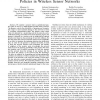Free Online Productivity Tools
i2Speak
i2Symbol
i2OCR
iTex2Img
iWeb2Print
iWeb2Shot
i2Type
iPdf2Split
iPdf2Merge
i2Bopomofo
i2Arabic
i2Style
i2Image
i2PDF
iLatex2Rtf
Sci2ools
INFOCOM
2007
IEEE
2007
IEEE
Optimal Jamming Attacks and Network Defense Policies in Wireless Sensor Networks
Abstract— We consider a scenario where a sophisticated jammer jams an area in a single-channel wireless sensor network. The jammer controls the probability of jamming and transmission range to cause maximal damage to the network in terms of corrupted communication links. The jammer action ceases when it is detected by a monitoring node in the network, and a notification message is transferred out of the jamming region. The jammer is detected at a monitor node by employing an optimal detection test based on the percentage of incurred collisions. On the other hand, the network computes channel access probability in an effort to minimize the jamming detection plus notification time. In order for the jammer to optimize its benefit, it needs to know the network channel access probability and number of neighbors of the monitor node. Accordingly, the network needs to know the jamming probability of the jammer. We study the idealized case of perfect knowledge by both the jammer and the ne...
Channel Access Probability | Communications | INFOCOM 2007 | Jammer Action Ceases | Sophisticated Jammer Jams |
| Added | 03 Jun 2010 |
| Updated | 03 Jun 2010 |
| Type | Conference |
| Year | 2007 |
| Where | INFOCOM |
| Authors | Mingyan Li, Iordanis Koutsopoulos, Radha Poovendran |
Comments (0)

